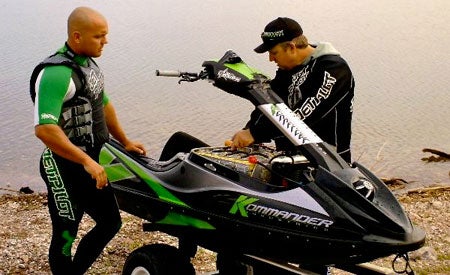Prominent Industry Names Behind Electric PWC Project
CWEcoSport testing out motor/battery combinations
A new startup company called CWEcoSport is hoping to develop a viable electric motor for the personal watercraft market. Named for the initials of its founders — freeride surf champ Ross Champion and Kommander Industries’ Steve Webster — the company is already well into development on the project, and recently tested a “proof-of-concept” motor and battery combination inside a stand-up craft.
“What we’ve built now isn’t a product we want to sell,” admits Champion. “It’s built as a proof of concept, really to prove to ourselves if it worked. And because it did work, and worked well, we decided to pursue it.”
Realistic Concept
The thought of an electric-powered PWC had been bouncing around in Champion’s brain for well over a year. Part of the reason is the type of surf riding he prefers. Many desirable locations have limitations on internal combustion engines. But Champion has also watched an electric-powered motorcycle grow in popularity. The combination led him to look into the available technology.
“There was some new technology on the horizon that was making this idea possible,” he continues. “If you look now, pretty much every major car manufacturer has a full electric, or hybrid, coming along. The time was just kind of right for it.”

The next step was to contact his friend and engine builder Webster. A former owner of a multi-line PWC dealership, Webster had recently focused his efforts on Kommander Industries, and building highly respected race motors for a number of the sport’s big names. Still, his days as a dealer exposed him to the occasional backlash against gas-powered PWC.
“Even after the arrival of the four-strokes, there was still somewhat of a black cloud,” says Webster of popular opinion. “There’s a tremendous amount of bad science out there. But no matter if it’s true or not true, people believe what they see on television and read in the news.”
Already a fan of electric motor technology, Webster listened to Champion and then proceeded to do his own research. “It became very clear that it was absolutely plausible and that we should do something, create a product that I think people could really appreciate.”
Emissions…And More

The idea of a zero-emissions PWC is certainly appealing for obvious environmental reasons. Those aren’t anything new. Champion also points out, however, that an electric motor would eliminate the need for a generous flow of oxygen, a need that currently makes an internal combustion engine susceptible to water intrusion. It’s particularly troublesome for surf and freestyle riders, who often submerge their craft. An electric motor could be sealed more effectively against water.
Webster also points out that an electric motor drastically reduces moving parts, a factor that increases reliability. “If you can create something that has less moving parts,” notes Webster, “your reliability factor goes up exponentially.”
Both admit there’s much to learn. Electric motors make a completely different type of power than an internal combustion engine. Those working with the technology are forced to consider the type of power, and how to convert it into speed and power through the jet pump. “Quite honestly we’re still working and making it better,” says Webster, “increasing the efficiency of the whole system.”

Electric motors do make substantial torque, however, and produce it almost instantly. In comparison, a gasoline engine needs to create a certain amount of horsepower before it begins to generate torque. The challenge has sent Webster “back to the drawing board” to analyze the relationship between pump, impeller, compression nozzle, and how all work together to reach the desired end result.
The gas and economic crunch of 2008-2009, however, has pushed electric technology to the forefront, and considerable money is being poured into both battery and motor technology.
“The technology is moving so rapidly,” he notes. “People have always been able to create tremendous power with electric, but now weight is coming down. There’s a big push globally. It’s pretty exciting to see when you embed yourself into that industry.”
Charge!
As to the most commonly discussed hurdles — a decent top speed and acceptable run time — the pair again says they can be overcome. Webster, in fact, likens it to the current situation with performance internal combustion engines, where builders have to balance the amount of power they want to produce with the amount of fuel the craft must carry.
“That’s certainly a hurdle, but with the electric motor you have a lot of control over how it makes power, you have options of a full power mode or range-extending mode,” adds Champion. “Everything’s very customizable as far as power delivery, so you can tailor it to what you want to do.”
Related Reading
DiMora to develop electric PWC
Electric PWC in the works that can go 50 mph
Get PersonalWatercraft.com in your Inbox!
Like PersonalWatercraft.com on Facebook
Comments
Most Popular

2025 Yamaha JetBlaster PRO 2-Up Review

2024 Kawasaki Jet Ski STX 160X Review

Remembering the Sea-Doo XP

Whatever Happened to the Wetbike?

2025 Yamaha JetBlaster Review












 Your Privacy Choices
Your Privacy Choices